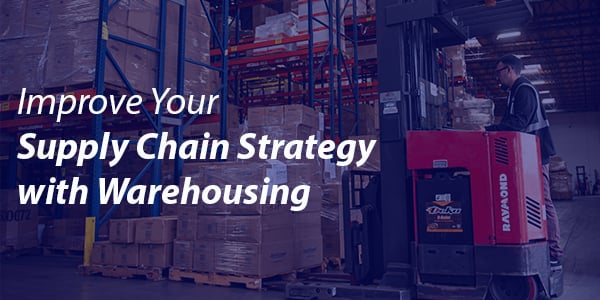
Speed to market is one of the most important benchmarks in every supply chain strategy.
Production and shipping delays are costly, which is why any plan for improving efficiencies should include warehousing, but setting up a place to store your goods presents a whole new set of challenges.
Land is expensive. Buildings are expensive. Even if your company leases a facility instead of buying it, you could still face a significant expense without a little planning—that’s where 3PLs fit into the picture.
Where Does Warehousing Fit into Your Operations?
Understanding your business capabilities and market demand are the first steps to figuring out how warehousing fits into your supply chain strategy.
How much can you sell? Can you control your inventory well enough to keep the warehouse operating at optimal levels? Can you afford the staffing costs and rent in the areas that serve as the main arteries for distribution?
When you start asking these questions, it becomes clear why the 3PL model is attractive to shippers. Smaller operations don’t want the expense of managing their own warehouse, so why not let other providers handle it?
Control of the process tends to be the main reason why some companies keep warehousing in-house. If maintaining your own workforce and distribution facilities is one of your organization’s core competencies, outsourcing may not make much sense.
On the other hand, 3PL providers offer a level of expertise that might not be attainable by keeping your storage facilities in-house. 3PLs provide logistical support with warehousing as a key component of their solution. It’s their specialty. Outsourcing can also free up capital expenditure and reduce exposure to risks and liabilities associated with the process.
Looking for the benefits of a 3PL Warehouse? We have a blog on that!
Location is Critical for Supply Chain Success
The size, location, and type of warehouse must be considered as well.
How much space do you need? If your market is in Los Angeles or New York, can you afford a 5,000 square-foot space in such a high-rent area? On top of that, many products need to be in a controlled environment. So, do you need a reefer warehouse or will ambient temperature suffice?
No matter the size or type of warehouse, location is important. If you can’t effectively stage your goods in a location that allows for rapid, cost-effective distribution, then it’s only a matter of time before there’s a break in the supply chain.
When Outsourcing Is the Best Option
Let’s imagine a company that brings goods to market in the Pacific Northwest.
They have a warehouse in Seattle, and everything is going well, so they decide to expand to an emerging market in Georgia. Should they make a land purchase or set up a long-term lease to serve potential customers in Atlanta, based on projections? Or, would it make more sense to use a 3PL model where the provider already has facilities in Atlanta?
Using a 3PL will insulate them from wasted land investment costs if the expansion fails. In this case, outsourcing allows an established company to test a new market before committing to land purchases or signing expensive leases.
Another reason to consider a 3PL is the extensive routing guide compliance that many large retailers require. The largest retail chains, and even mid-size retailers, provide their suppliers with routing guide documents that detail how goods will be packaged and labeled (including label size and placement), which ground carrier to use, when they will accept deliveries, and much more. Failure to comply with routing guides can result in chargebacks to the supplier, a penalty charge for non-compliance that represents a revenue stream for retailers. 3PLs will have the most recent routing guides and the expertise to ensure compliance.
Warehouses help make the entire supply chain more efficient.
They allow companies to consolidate and house products while awaiting shipment to customers. Among the many services warehouses facilitate, they can help to reduce transportation costs when the facilities are strategically located.
The 3PL model allows for optimal agility. Most 3PLs have warehouses located at ground-transportation hubs across North America. Some even have warehouses set up in free-trade zones. Furthermore, a 3PL has warehouse staff experienced with handling various types of goods, like consumer goods or pharmaceuticals.
For high-volume operations with a well-established supply chain, it may make financial sense for those companies to invest in their own warehouses and staff. Either way, warehouses should be one of the first things on your mind when planning your supply chain.



